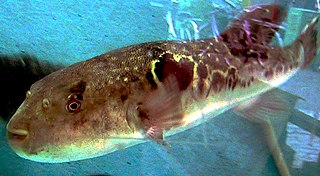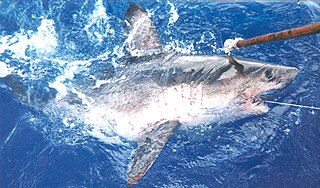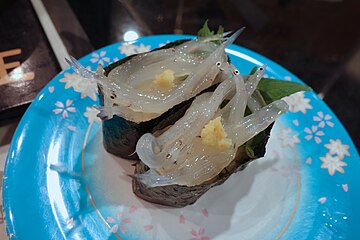
A tuna is a saltwater fish that belongs to the tribe Thunnini, a subgrouping of the Scombridae (mackerel) family. The Thunnini comprise 15 species across five genera, the sizes of which vary greatly, ranging from the bullet tuna up to the Atlantic bluefin tuna, which averages 2 m (6.6 ft) and is believed to live up to 50 years.

Sashimi is a Japanese delicacy consisting of fresh raw fish or meat sliced into thin pieces and often eaten with soy sauce.

Fish migration is mass relocation by fish from one area or body of water to another. Many types of fish migrate on a regular basis, on time scales ranging from daily to annually or longer, and over distances ranging from a few metres to thousands of kilometres. Such migrations are usually done for better feeding or to reproduce, but in other cases the reasons are unclear.

The brown trout is a species of salmonid ray-finned fish and the most widely distributed species of the genus Salmo, endemic to most of Europe, West Asia and parts of North Africa, and has been widely introduced globally as a game fish, even becoming one of the world's worst invasive species outside of its native range.

The Osmeriformes are an order of ray-finned fish that includes the true or freshwater smelts and allies, such as the galaxiids and noodlefishes; they are also collectively called osmeriforms. They belong to the teleost superorder Protacanthopterygii, which also includes pike and salmon, among others. The order's name means "smelt-shaped", from Osmerus + the standard fish order suffix "-formes". It ultimately derives from Ancient Greek osmé + Latin forma, the former in reference to the characteristic aroma of the flesh of Osmerus.

Takifugu, also known by the Japanese name fugu, is a genus of pufferfish with 25 species, most of which are native to salt and brackish waters of the northwest Pacific, but a few species are found in freshwater in Asia or more widely in the Indo-Pacific region. Their diet consists mostly of algae, molluscs, invertebrates and sometimes crustaceans.

Alosa is a genus of fish, the river herrings, in the family Alosidae. Along with other genera in the subfamily Alosinae, they are generally known as shads. They are distinct from other herrings by having a deeper body and spawning in rivers. Several species can be found on both sides of the Atlantic Ocean and the Mediterranean Sea. Also, several taxa occur in the brackish-water Caspian Sea and the Black Sea basin. Many are found in fresh water during spawning and some are only found in landlocked fresh water.

The Arctic char or Arctic charr is a cold-water fish in the family Salmonidae, native to alpine lakes, as well as Arctic and subarctic coastal waters in the Holarctic.

Many species of fish are caught by humans and consumed as food in virtually all regions around the world. Fish has been an important dietary source of protein and other nutrients.
Salangidae, the icefishes or noodlefishes, are a family of small osmeriform fish, related to the smelts. They are found in Eastern Asia, ranging from the Russian Far East in the north to Vietnam in the south, with the highest species richness in China. Some species are widespread and common, but others have relatively small ranges and are threatened. Depending on species, they inhabit coastal marine, brackish or fresh water habitats, and some are anadromous, only visiting fresh water to spawn.

The salmon shark is a species of mackerel shark found in the northern Pacific ocean. As an apex predator, the salmon shark feeds on salmon, squid, sablefish, and herring. It is known for its ability to maintain stomach temperature (homeothermy), which is unusual among fish. This shark has not been demonstrated to maintain a constant body temperature. It is also known for an unexplained variability in the sex ratio between eastern and western populations in the northern Pacific.

The giant mottled eel, also known as the marbled eel, is a species of tropical anguillid eel that is found in the Indo-Pacific and adjacent freshwater habitats.
The Japanese snapper is a species of marine ray-finned fish, a snapper belonging to the family Lutjanidae. It is native to the Western Pacific Ocean.

The Pacific bluefin tuna is a predatory species of tuna found widely in the northern Pacific Ocean, but it is migratory and also recorded as a visitor to the south Pacific.

The twait shad or twaite shad is a species of fish in the family Alosidae. It is found in the eastern Atlantic Ocean and the Mediterranean Sea and is an anadromous fish which lives in the sea but migrates into fresh water to spawn. In appearance it resembles an Atlantic herring but has a row of six to ten distinctive spots on its silvery flanks. They become mature when three or more years old and migrate to estuaries, later swimming up rivers to spawn. Populations of this fish have declined due to overfishing, pollution and habitat destruction. Conservation of this species is covered by Appendix III of the Bern Convention and Appendix II and V of the European Community Habitats Directive.
The ariakehimeshirauo, Neosalanx reganius, is a species of icefish in the family Salangidae endemic to Japan. It is only known from Midori and Chikugo Rivers in Kyushu. Its maximum total length is 63 mm (2.5 in), and has a lifespan of about one year. It seems to be relatively rare in its limited habitat, and is classified as an endangered species by IUCN.
Neosalanx is a genus of icefishes native to Eastern Asia, ranging from Korea, through Japan and China, to Vietnam. They inhabit coastal marine waters, estuaries and river basins. There are both species that are threatened and species that are widespread.
Neosalangichthys ishikawae, the Ishikawa icefish, is a species of Salangidae that is endemic to marine waters near the coast in northern Honshu, Japan. Originally placed in the genus Salangichthys, the species was assigned in 2012 to the monotypic genus Neosalangichthys. Adults stay in relatively shallow open marine waters, but larve and immatures typically stay off beaches, often in the surf zone, in waters that range from marine to brackish. Unlike the more widespread S. microdon with which it often occurs, N. ishikawae does not occur in fresh water.
Protosalanx is a small genus of icefishes that are native to China, Korea and Vietnam where they primarily inhabit coastal waters and nearby fresh waters. They are commercially fished and used for aquaculture in China, where also introduced to some inland waters like Lake Dianchi. In addition to being eaten locally in Asia, they are exported to southern Europe as a replacement of the more expensive transparent goby, a Mediterranean species used in the local cuisine. This replacement is often done openly, but sometimes it is done fraudulently.

Coilia nasus, also known as ungeo and the Japanese grenadier anchovy or Chinese tapertail anchovy is a species of ray-finned fish from the family Engraulidae (anchovies). It grows to 41 cm (16 in) total length; it is a relatively large species for its genus. It is found in marine, freshwater, and brackish water at depths down to 50 m (160 ft). It is an example of an anadromous fish species, with some populations moving to freshwater to spawn. Overall they are distributed in the northwest Pacific, between 21–42°N and 109–134°E, or from Guangdong in China to the west coast of the Korean peninsula and the Ariake Sound in southwestern Japan. A traditional delicacy, the species is commercially fished in Korea, China and Japan. In China it is one of the most expensive fish sold, and as the anadromous variety is more expensive than the freshwater variety, the industry is mostly focussed in the Yellow Sea, East China Sea, and Yangtze.















